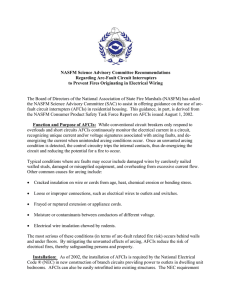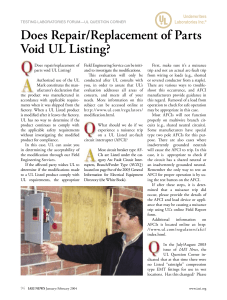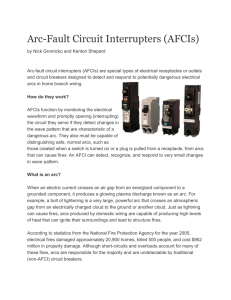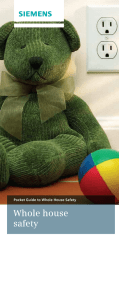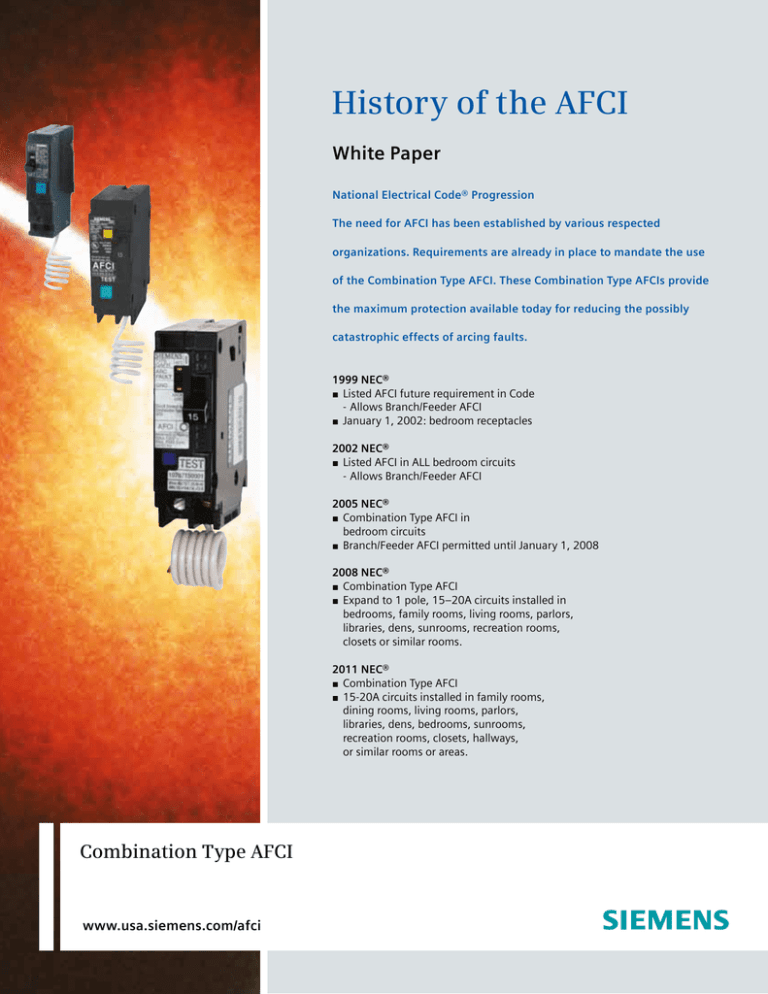
History of the AFCI
White Paper
National Electrical Code® Progression
The need for AFCI has been established by various respected
organizations. Requirements are already in place to mandate the use
of the Combination Type AFCI. These Combination Type AFCIs provide
the maximum protection available today for reducing the possibly
catastrophic effects of arcing faults.
1999 NEC®
J Listed AFCI future requirement in Code
-Allows Branch/Feeder AFCI
J January 1, 2002: bedroom receptacles
2002 NEC®
J Listed AFCI in ALL bedroom circuits
-Allows Branch/Feeder AFCI
2005 NEC®
J Combination Type AFCI in
bedroom circuits
J Branch/Feeder AFCI permitted until January 1, 2008
2008 NEC®
J Combination Type AFCI
J Expand to 1 pole, 15–20A circuits installed in
bedrooms, family rooms, living rooms, parlors,
libraries, dens, sunrooms, recreation rooms, closets or similar rooms.
2011 NEC®
J Combination Type AFCI
J 15-20A circuits installed in family rooms,
dining rooms, living rooms, parlors,
libraries, dens, bedrooms, sunrooms,
recreation rooms, closets, hallways,
or similar rooms or areas.
Combination Type AFCI
www.usa.siemens.com/afci
AFCIs: Big fire prevention in a small package
The Electrical Safety Foundation International (ESFI) has stated that
one technology could save “hundreds of lives, reducing thousands
of injuries and nearly $1 billion in property damage annually.” a The
United States Fire Administration (USFA) has partnered with the
National Association of State Fire Marshals (NASFM) to urge
homeowners to install it. The Consumer Product Safety Commission
(CPSC) has helped educate the public about its benefits.
Underwriters Laboratories (UL) has listed products from four
manufacturers after extensive testing for reliability and effectiveness.
The Executive Director of Standards and Safety for the National
Electrical Contractors Association (NECA) further describes them as
being “on the front line of home electrical safety.” b
What are these remarkable devices? Arc Fault Circuit Interrupters
(AFCIs). These specialized circuit breakers detect the hidden
problems sparking 82 percent of all electrical fires, according to
an estimate by NASFM.c Based on USFA statistics from 2006, that
amounts to approximately 67,800 electrical fires annually – fires that
may be prevented if only the houses are equipped with AFCIs.d
Unfortunately, in most cases, they aren’t.
Why not? Because after a decade of commercial availability, AFCIs
are just beginning to work their way into the nation’s housing stock.
Slow building code updates, special interest opposition to AFCIs, and
lack of awareness among home buyers all contribute to the problem.
Put these factors together, and the changeover simply isn’t
happening fast enough.
The evolution of AFCIs into an established technology
The problem of arc faults has been recognized for the
better part of the 20th Century – virtually the entire time that electricity has been in widespread use. In fact, patent applications related
to arc fault protection date back to the 1930s. Applications peaked
between 1990 and 2005 and have virtually disappeared since, a
trend that is characteristic of a mature technology (see Figure 1).
Approximately three-fourths of those deaths occurred in residential
fires. Furthermore, the study found that “fires in residential electrical
distribution systems are an important contributor to this problem.” e
The USFA report helped prompt the U.S. Consumer Product Safety
Commission to delve deeper into the cause of electrical fires. But
most of the existing electrical fire data available to the CPSC from
local fire departments blamed “failure of electrical wiring,” a generic
description that did little to help pinpoint the real cause of electrical
fires.f
To get better data, the CPSC paid the USFA to train fire
investigators in select cities to analyze electrical fires for the root
cause.g The inspectors gathered detailed data on 149 fires in 16
cities in 1980-81 and 1984-85. A final report completed in December
1987 found that electrical fires occurred most often in branch circuit
wiring, followed by receptacle outlets and extension cords.
In 1993, the Electronic Industries Alliance (EIA) and UL attempted
to identify a solution for the specific problem of arcing faults in
appliance and extension cords. Since arcing faults often lead to
short circuits, they sought to define an appropriate decrease in the
short-circuit trip level of circuit breakers. This was determined by
an analysis of the available current at receptacle outlets. The report
found a tradeoff between increased protection and nuisance tripping
due to high initial currents associated with certain electrical
appliances at turn-on. A proposal to the 1996 National Electric Code
(NEC) was rejected unanimously with the NEC Code Making Panel
recommending “a more complete analysis of actual cord problems
and alternate solutions such as other cord constructions,
supplemental overcurrent protection, and electronic sensing is
needed.”
Around this time, the CPSC began work on a more comprehensive
study to identify a technical solution to mitigate the risk of electrical
fires. In December 1994, the CPSC issued a call to 800 domestic and
foreign manufacturers, asking them to submit any promising new
technology for evaluation. The request was republished in the
January 2005 edition of UL Trends. Nineteen inventors and
manufacturers responded, and 11 products were submitted for
testing. The CPSC retained UL to evaluate five technologies: arc-fault
detection, modified-trip circuit breakers (similar to those in the EIA/
UL study), ground-fault circuit interrupters, supplementary
protection, and surge protection.
After months of testing, UL concluded in September 1995 that “from
the technologies analyzed, arc-fault detection appeared to be very
promising, especially when added to residential branch-circuit
breakers and combined with other proven technologies such as
ground-fault protection.” h
Figure 1: History of arc-fault and arc-detection patent applications
Although arc faults have been recognized as a problem for a long
time, the hunt for a commercially viable technology gained
significant momentum almost 30 years ago. In 1980, the USFA
commissioned a fire loss comparison study that showed the U.S.
suffered one of the world’s highest death rates from fire – two to
four times higher than experienced in European countries.
2
AFCIs enter the commercial mainstream
UL and NEMA collaborated on the creation of a draft standard
defining a set of operational requirements for AFCIs in December
1996.i AFCIs began appearing commercially in 1997, and the CPSC
tested the devices from multiple manufacturers to determine if they
could reliably detect arc faults without tripping in the presence of
operational arcing, which occurs in motors, switches, etc. The tests
generally followed the requirements in the draft UL standard,
although the CPSC included several tests for unwanted tripping that
were not included in the standard. In spite of this, all the AFCIs
detected the presence of arc fault conditions while avoiding
nuisance tripping.j
In the fall of 1997, UL began work on conversion of the draft
standard into UL 1699, Standard for Arc-Fault Circuit Interrupters,
which was published in February 1999. UL announced the standard
in an article headlined: “AFCIs show promise to save lives by
preventing electrical fires.”k
During this time, the NEC Code Making Panel began to consider
proposals to require AFCIs as part of the NEC. In 1997, three separate
proposals were made to require AFCIs in the 1999 NEC. This resulted
in a 1999 NEC requirement of AFCI protection for 15-amp and
20-amp bedroom receptacles beginning January 1, 2002. The 2002
NEC expanded the requirement for AFCI protection to include not
only bedroom receptacles, but all 15A and 20A bedroom circuits.
Reacting to the development of new technology, the 2005 NEC
requires Combination Type AFCIs, which detect more types of arc
faults, beginning January 1, 2008. Branch/Feeder AFCIs are
permitted until that date. The 2008 NEC expands Combination Type
AFCI protection beyond bedrooms to also include family rooms, living
rooms, parlors, libraries, dens, sun rooms, recreation rooms or similar
rooms. This will provide even more electrical safety protection in the
home.
A timeline of the history of AFCI development is shown in Figure 2
of this paper.
Proven technology, widely endorsed
In 2007, AFCIs mark a decade of commercial availability. In that time,
the technology has been endorsed by a wide range of public and
private organizations:
protect homes and families from fires caused by electrical arcing,” observes ESFI President Brett Brenner.
Proven technology for a proven need
If 2007 is like 2006 – and virtually every other year since electricity became commonplace in American homes – electrical problems
will cause approximately 67,800 home fires, $868 million (2006)
in property damage, more than 485 deaths and more than 2,300
injuries.l
Thanks to AFCIs, many of the deaths and injuries and most of the
property damage could be prevented. AFCIs work, and they’ve been
proven in hundreds of laboratory tests and years of commercial use.
But AFCIs only work where they are installed, and most of the
nation’s homes don’t have them.
The solution is simple, though it will take time. State and local
building code committees should follow the example of the NEC
and require AFCIs in all new homes. Meanwhile, owners of existing
homes should hire licensed electricians to install the technology. In
the hands of a skilled technician, the job typically does not require
rewiring and costs only a few hundred dollars per home, a small
price for the safety of one’s family.
With a little concerted effort, arcing-fault induced fires, deaths, and
injuries could be virtually eliminated over time. The need is clear and
the technology is proven. All that remains is the will to make arcing
fault fires a thing of the past.
aElectrical Safety Foundation International, news release,
November 7, 2005.
b“NECA Stands Up for Arc-Fault Circuit Interrupters,” National
J Consumer Product Safety Commission. This U.S. government
Electrical Contractors Association website, www.necanet.org, agency reports that its electrical engineers “have tested the new
February 10, 2004.
AFCIs on the market and found these products to be effective.” In
c National Association of State Fire Marshals, Consumer Product addition, the Consumer Product Safety Commission (CPSC) has
Safety Task Force report, 2002.
helped educate the public about the benefits of AFCIs.
d “On the Safety Circuit: A Fact Sheet on Home Electrical Fire
J U.S. Fire Administration. Also a US government agency, USFA
Prevention,” U.S. Fire Administration, March 2006.
advocates AFCIs, noting in its literature that “CPSC has identified AFCI technology as an effective means of preventing fires caused e “Selected International Comparisons of Fire Loss,” by Jerry Banks and Ronald L. Rardin, Georgia Institute of Technology,
by electrical wiring faults in the home.”
December 1980.
J National Association of State Fire Marshals. This group, which f “CPSC Staff Activities on Electrical Fires,” by Douglas Lee, U.S. represents state-level fire officials, “strongly supports the broad Consumer Product Safety Commission, undated (circa 2001).
adoption of AFCI technology through national, state, and local building codes,” according to its president, John C. Dean. “AFCIs are g Ibid.
h “ Technology for Detecting and Monitoring Conditions that Could the most welcome addition to fire prevention in decades. AFCIs Cause Electrical Wiring Fires,” Underwriters Laboratories Inc., UL promise to save hundreds of lives every year.”
Project Number: NC233, 94ME78760, CPSC Contract Number J National Electrical Contractors Association. NECA has fought to CPSC-C-94-1112, September 1995.
keep AFCIs in state and local building codes, urging state
i “New Technology for Preventing Residential Electrical Fires:
legislatures to stand up to those who would put profit ahead of Arc-Fault Circuit Interrupters (AFCIs),” by Douglas A. Lee et al, consumer safety. “AFCIs are right there on the front line of home undated (circa 1999).
electrical safety,” says Brooke Stauffer, executive director for
j Ibid.
standards and safety at NECA. “They add very little to the cost of
wiring a new house but a large measure of extra protection for the k “AFCIs Show Promise to Save Lives by Preventing Electrical Fires,” by Dave Dini and Rich Wagner, Underwriters Laboratories
occupants. Opposing AFCIs in new residential construction is newsletter, 1999.
incredibly short-sighted.”
l “On the Safety Circuit: A Fact Sheet on Home Electrical Fire
J National Association of Home Inspectors. “NAHI strongly
Prevention,” U.S. Fire Administration, March 2006.
encourages its members to educate all of their clients about the life- and property-saving benefits of AFCI technology, especially those clients considering the purchase of a home more than 20 years old,” says Executive Director Mallory Anderson.
J Electrical Safety Foundation International. “ESFI urges that AFCI technology be installed in all new and existing housing to
3
Brief description
Timeframe
Source
Documented damages on 277/480V systems due to arcing
GFCI requirement followed — results indicated that GFCI did not properly
address issue
1960s
Arcing faults and their effect on the settings of
ground fault relays in solidly grounded low voltage
systems
CPSC identified concern with residential fires of electrical origin
late 1980s, early
1990s
IAEI News, Apr. 1, 1988
CPSC fact finding efforts to determine root cause of electrical fires
1980s
NEC Digest, Fall 2003
Arc fault detection technology concepts demonstrated to UL
early 1990s
CPSC, Sept. 1995
NEC proposal to reduce instantaneous trip levels of breakers to address
issues with arcing (EIA)
Proposal rejected due to nuisance concerns; not supported by NEMA
1993
CPSC, Sept. 1995
Arc fault detection technology appears in circuit breakers
1993
NFPA Journal, Oct. 25, 1993
CPSC reviews technologies to reduce electrical fires, including arc fault
detection
1994
NFPA Journal, Sept. 1995
CPSC investigation finds that arc fault detection is a very promising
technology
Dec-1994 through
Sept-1995
NFPA Journal, Sept. 23, 2003
First commercial AFCIs available
1997
NFPA Journal, 1997
First proposal to NEC requiring AFCI protection
1997
IAEI News, 1999
UL forms Industry Advisory Group to create a Standard for Safety for
AFCI products
1998
UL, Sept. 1995
1999 NEC requires AFCI for bedroom receptacle circuits
Sept-1998
NFPA, Sept. 1998
UL released “Standard for Safety for Arc-Fault Circuit Interrupters”, UL 1699
Feb-1999
NFPA Journal, Feb. 1999
2002 NEC requires AFCI for all bedroom circuits
Sept-2001
NFPA, Sept. 2001
CPSC determines AFCI proves cost effective
Mar-2003
CPSC, Summer 1999, Vol. 4 No. 1
2005 NEC requires AFCI for all bedroom circuits
Sept-2004
NFPA, Sept. 2004
U.S. Fire Administration advocates AFCI technology.
Dec-2006
USFA, Dec. 28, 2006
Figure 2: AFCI timeline
Siemens Industry, Inc.
5400 Triangle Parkway
Norcross, GA 30092
1-800-241-4453
info.us@siemens.com
www.usa.siemens.com/afci
Subject to change without prior notice
Order No.: RPFL-COMB2-0812
All rights reserved
Printed in USA
© 2012 Siemens Industry, Inc.
The information provided in this brochure contains merely
general descriptions or characteristics of performance
which in case of actual use do not always apply as described
or which may change as a result of further development
of the products. An obligation to provide the respective
characteristics shall only exist if expressly agreed in the
terms of contract.
All product designations may be trademarks or product
names of Siemens AG or supplier companies whose use by
third parties for their own purposes could violate the rights
of the owners.

